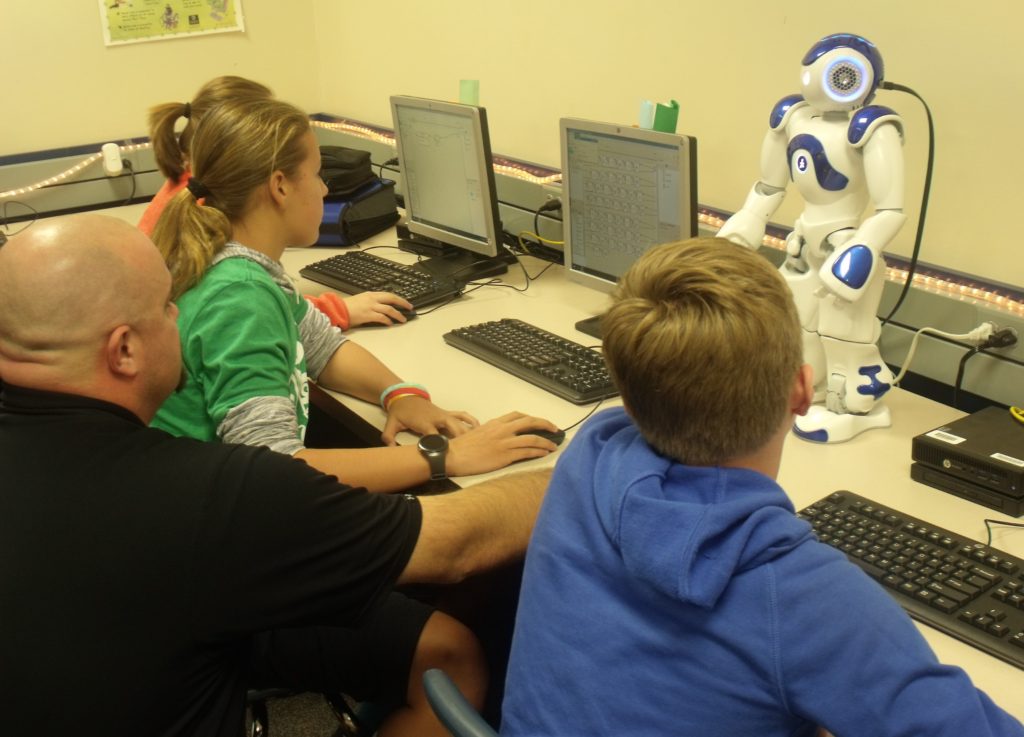With guidance from teacher Jason Whiting (left), students at Patrick Henry Middle School work on programming a 2-foot-high robot.
The center of attention in some classes led by Jason Whiting stands only 2 feet tall, weighs about 10 pounds and goes by the name Juan Pablo.
Juan Pablo is a new, humanoid robot capable of walking around, talking 15 languages, moving its arms and hands, and even recognizing faces.
“It’s amazing what it can do, but only if it’s been programmed to do it,” said Whiting, who has been teaching for nine years.
Whiting currently teaches information and communication technology, and career and technical education at Patrick Henry Middle School. He uses the robot to help teach eighth-graders about basic computer programming and code writing.
There is only one robot, so most of the students in Whiting’s classroom typically work at developing commands with a virtual image of Juan Pablo on their computer screens.
Whiting bought the robot with the help of a $7,150 Innovation in Education grant from the Education Foundation. The award was the biggest single grant ever awarded by the Education Foundation.
The grant was one of 21 awarded by the Education Foundation to teachers in Sioux Falls Public Schools for 2017-2018 school year. This year’s grants totaled $40,000.
The application deadline for grants for the 2018-2019 school year will be Feb. 23, 2018. Teachers may apply at https://sfeducationfoundation.org/teachers/apply-for-a-grant/. Staff members from any grade level in the School District are eligible to apply.
Innovation in Education Grants are designed to provide funding help for creative educational materials, programs and projects not funded by tax dollars. Money for the grants comes from donations from business and individuals.
The robot was demonstrated in August at the fourth annual Innovation In Education Breakfast, which is the Education Foundation’s signature event.
Whiting raised $1,000 in additional funding to help buy the Nao robot at a discounted price from SoftBank Robotics.
Whiting said he wouldn’t have been able to buy the robot without the grant from the Education Foundation.
The Education Foundation’s Grants Review Committee cut the $8,150 that Whiting requested by $1,000, which enabled the organization to fund another grant.
However, committee members appreciated Whiting’s enthusiasm and commitment to the robot project, said Nancy Duncan, coordinator of the Grant Review Committee.
“I think one of the things that intrigued the committee that reviewed the grants was the integration of the technology of programming the robot and serving students who could benefit from working with the robot,” Duncan said. “It just seemed like a real win-win situation.”
Indeed, Whiting said the robot has been a phenomenal tool for stimulating engagement in students. “I’ve got students who want nothing to do with computer programming but love working with the robot,” he said.
At the suggestion of his daughter, Whiting initially named the robot Fred. But students at Patrick Henry picked the name Juan Pablo in a school-wide election.
Students are expected to pick a fresh name for the robot every year, and the new name will be added to its moniker. So, technically, the full name of the robot currently is Fred Juan Pablo.
Regardless of what it might be called in the future, the robot is helping Whiting as well as students expand their understanding of how technology works.
“My students are teaching me about how to use him, which is great,” Whiting said.
To read all of the articles in the latest edition of the Foundation Newsletter, click to download your copy. November 2017 Newsletter

